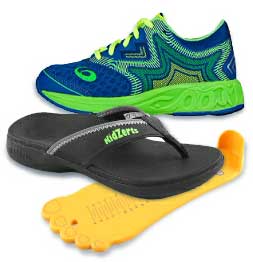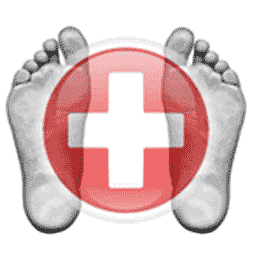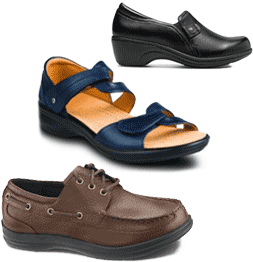| A | B | C | D | E | F | G | H | I | J | K | L | M | N | O | P | Q | R | S | T | U | V | W | X | Y | Z |
A
Aglet: The plastic sheath at the end of a shoelace that makes the lace easier to thread through the eyelet of the shoe.
Airport Friendly Shoes: Footwear that contain no metal allowing the wearer to pass through airport metal detectors without setting off the alarm
Aniline Leather: Leather that has been finished using an aniline dye in order to give it a natural look
Apron Toe Shoes: A type of toe covering with visible edges or stitching that forms an apron over the front of the shoe
Arch: The high curved part of the sole of the foot, located between the ball of the foot and the heel. May also refer to the raised area of the insole of the shoe, which pads and supports the arch of the foot.
Arch Cookie: A foam insert placed under the insole, designed to support the arch
Arch Spring: The upward curve of the arch of a last or footwear
Arch Support: Stiffening effect on the area of the insole built up and strengthened to support the arch of the foot, or a similar support which can be inserted into the shoe separately. (Shop Arch Support Products)
B
Back Seam : The seam that runs up the back of the shoe.
Ball: The padded area of the foot between the big toe and the arch of the foot.
Ball Girth: The circumference of the foot around the ball of the foot.
Ball Line: A line drawn across the widest portion of the foot.
Bellows Tongue: A shoe tongue that is attached at both the top and the sides of the shoe.
Blucher: A shoe construction featuring two side flaps of material that are joined across the foot for lacing. This is preferable for adjustability as well as those with a high arch.
Bevelling: Reducing the substance of certain components of the shoe bottom by skiving (insole seat beveling).
Board Lasting: Board lasted shoes have a sturdy insole board running the entire length of the foot bed. This type of construction provides the greatest stability.
Boat Shoes: A Type of shoe originally meant to worn aboard a boat, usually with a siped, non-slip outsole with side lacing details. (Shop Boat Shoes)
Boot: A style of footwear extending to the height of the ankle bone or higher. (Shop All Boots)
Brannock Device: A Device used to measure the length and width of the foot inorder to ensure proper fit. (For help with sizing, view our Shoe Fitting Guide)
Break : The natural crease created across the vamp of the shoe from everyday wear.
Brogue: A heavy oxford-style shoe featuring pinked or perforated detail.
Buckle: A clasp that joins one end of material to another, maybe functional or decorative.
C
Calf Leather: The skin of very young cattle which offer fine grain, suppleness and exceptional durability.
Calfskin Leather: Leather made from the skins of very young cattle. Among the highest quality of all leathers.
Calluses: A firm rough patch of skin that develops from overuse or irritation.
Cemented Construction: A shoe construction in which the upper of the shoe is cemented rather than stitched to the sole of the shoe. Results in a lighter more flexible shoe.
Chukka Boots: Mens low boots with cap less vamp and high cut quarters that cover the ankles. Normally with two holes but not more than three eyelets used. (Shop Men's Boots)
Cleaning Nubuck Leather: Should be wiped with a cloth dipped in slightly soapy warm water.
Cleaning Patent Leather: Clean with a damp cloth or use a good quality proprietary patent leather spray.
Cleaning Suede Shoes: After removing all dirt when dry, bush up the nap using a rubber or stiff bristled brush.
Clog: A footwear style featuring a closed toe, open back and a platform sole traditionally fashioned of wood. (Shop All Clogs)
Combination Last : A footwear last in which the heel is two sizes smaller in width than the widest part of the shoe, producing a shoe with a narrow heel and wide toebox.
Contoured Footbed: An insole that molds to the foot.
Collar: A stitched on strip of leather around the outside of the top of the shoe. Sometimes padded which providesa more secure heel fit and helps prevent debris from entering the shoe. (Shop Padded Collar Shoes)
Compression Molded Ethylene Vinyl Acetate Foam: CM-EVA used in the midsole for cushioning.
Cordovan Leather: Cordovan is a shoe color and most commonly the leather is taken from a horse's posterior. When the leather is tanned it becomes a rich black cherry color, and as such has evolved into common usage as a color name.
Corn: A small hard formation usually found at the toe. A corn is usually the result of continuous friction of pressure in one place. (Shop Corn Products)
Counter: A stiff piece of material placed at the heel of the shoe between the lining and upper in order to retain the shape of the shoe.
D
D-ring : Plastic or metal eyelets placed along the eyestay which aid in ease of lacing, support and security of fit.
Dorsiflex : To flex the foot upward so the the dorsum (upper surface) approaches nearer to the leg.
Dual Density : Term used to describe some midsole or sole designs. One layer is denser than the other. Denser layer provides stability and softer layers provide cushioning (in running shoes the denser foam is used where the foot would roll).
Duty Shoes : A health care professional or service shoe.
E
Elastic Gore : An elastic fabric panel inserted into shoes to provide stretch.
Embossing : A method of decorating leather by pressing a heated die onto the surface.
Energy Return : Running and athletic shoes, it is the response after the foot strikes the ground, propulsion that helps maintain an effective gait" or stride. Eyelet: Hole for the laces to pass through.
Eyelet Tab : The front part of the quarters, overlaying the instep, carrying the eyelets.
Eyestay : Reinforcement around the eyelet holes.
F
Fiberboard : Material primarily made of wood pulp which is used for counters, insoles and heel lifts.
Fisherman Sandals : Type of sandal with woven or stitched vertical or horizontal straps, often with a closed toe. (Shop Sandals)
Footbed : Another name for insole, the part of the shoe your foot lies directly on.
Forefoot : The area of the foot between the ball and the toes.
Flare: Refers to the width of the heel at the bottom of the outer sole in relation to the width of the heel at the top of the outsole. Increases stability.
Full Grain Leather: The entire thickness of the hide is used to increase durability.
Full Sock: A piece of leather or fabric pasted or kept on the insole of the shoe to cover any grindery and stitching inside the shoe.
G
Gait: An individuals style of walking.
Ghillie : A style of footwear in which the laces pass through fabric or leather rings or loops attached to the front of the shoe, rather than eyelets.
Goodyear Welt : A shoe construction in which the upper and the sole of the shoe are stitched together resulting in greater durability.
Gimping: Saw-toothed edge to leather resembling pinking fabric.
Grain: The pattern of pores and other surface characteristics of the animal concerned, visible on the outer surface of a hide once the hair has been removed.
Grain Leather: Any leather on which the original natural grain has been processed.
Graphite Rollbar : A lightweight flat or molded piece of graphite material biomechanically positioned in the midsole to maximize rearfoot stability.
H
Half Bellows : A full length tongue attached to the vamp and all the way up on both sides of the quarters.
Hallux Ridge: A slightly pronounced ridge between the base of the toe and the ball of the foot on the shoe's footbed. The Hallux Ridge enables natural hold by the big toe, preventing the foot from slipping forward and improving the foot's hold on the shoe.
Hammertoes: A condition in which the toe is bent in a claw like position, occurring most frequently in the second through the fifth toes, usually caused my muscle imbalance. (Shop Hammertoes)
Hallux Rigidus : A painful affliction of the great toe with restriction of movement, the toe being held in the extended position, very little dorsiflexion.
Hallux Valgus : A sideways deviation of the great toe towards the midline of the foot. It is associated with the development of a prominence on the inner side of the joint which than develops a protective bursa.
Heel : Can refer to both the rear, padded area of the underside of the foot, as well as the solid part of a shoe that supports the heel cup. The standard measure for heel heights is as follows: am 8/8 (low heel) is 1" high a 16/8 (medium heel) is 2" high.
Heel Height : Is measured on a vertical line at the breast of the heel, from the bottom surface of the sole where it meets the heel, to the floor.
Heel Seat : The part of the shoe directly below where the heel of the foot rests and where the heel and the sole are joined together.
Heel Spurs : Soft deposits of calcium that grow on the plantar fascia, a band of tissue that grows along the bottom of the foot. (Shop Heel Spur Products)
Heel Pitch : Angle between axis of heel and base line.
House Shoe : Another name for a slipper.
Huarache: A flat sandal or shoe with a woven leather upper.
Hyperidrosis : Excessive sweating of the feet.
I
Ingrown Toenail : Nails whose corners or sides digs painfully into the skin. They may be caused by improper nail trimming, shoe pressure, injury, fungus infection, heredity, or poor foot structure.
Inseam: The hidden seam of a welted shoe holding together the welt, upper, lining and insole.
Insock: A thin layer of materials put in to the shoe after manufacture to cover the insole.
Insole: The cushioned part of the shoe the foot rests upon. (Shop Orthotics / Shop Footwear With Removable Insoles)
Instep: The area of the foot between the toes and the ankle, or the top front of the shoe.
Instep Girth Measurement : The girth measurement of a last or foot taken at the waist through the instep point.
K
Kiltie : Decorative fringed tongue over the instep or vamp of the shoe.
L
Lace Stay: A strip of leather applied to the front of a laced boot or shoe to strengthen and reinforce the eyelets or eyelet holes.
Lace Up Shoes : Any low cut shoe fastened by lacings such as an Oxford or Blucher.
Laces : A strip of material strung through the eyelets of the shoe in order to pull the shoe closed and adjust the girth.
Last : A shape or form. Usually made of wood, that represents the space inside the shoe. It is used to construct the shoe and give it shape.
Lyrca/Neoprene: A blend of stretch fabric and neoprene rubber, ideal for a waterproof and sporty soft lining.
M
Mary Janes: A type of womens shoe characterized by a strap across the instep. (Shop Mary Janes)
Metatarsal Bones : Five long bones in the foot that help to move the body forward when walking or running. They form the top slope of the foot.
Medial : Referring to the inner side (arch) of a shoe.
Medial Post : Denser CM-EVA foam, TPU device, or a combination of both on the inside edge of the shoe to curb pronation. (Shop Medial Post Footwear)
Mesh : A woven nylon used in upper construction, has excellent breathability. (Shop Mesh Shoes)
Metatarsalgia : An extremely painful condition of the forefoot, starting with a burning sensation in the fourth metatarsal head region. (Shop Metarsalgia Products)
Midsole : A cushioning layer between the outsole and the upper. Materials may include EVA, PU, compression molded EVA, that absorbs shock and provides stability.
Moccasin : A loafer in style with more distinctive stitching, usually flat and made of suede. (Shop Moccasins)
Motion Control : Designs or devices found in athletic shoes that control the inward rolling of the foot. (Shop Motion Control products)
Mule : A slipper or shoe without quarters, held onto the foot by the forepart only.
N
Nap : Velvety surface of leather or cloth.
Nappa Leather: Sheepskin leather typically less than two years old, more supple than other sheepskins.
Negative Heel : Popular in comfort footwear, a type of footwear with a lowered heel area designed for more natural foot placement.
Nubuck : Is a grain leather that has been slightly brushed on the surface to create a very fine velvet-like appearance.
O
Onychogryphosis : Gross overdevelopment of the nail, usually the great toe, caused by trauma or infection.
Orthotic : A corrective device made primarily of leather or plastic which is placed in the shoe to correct biomechanical insufficiencies. (Shop Orthotics / Shop Footwear With Removable Insoles)
Outsole : The very bottom of the shoe the part that contacts the ground.
Oxford Shoes : A man's style with a closed front, that is with the quarters stitched under the vamp.
P
Padding : A thin cushion like mass of soft material used to fill, to give shape, or to protect against jarring, scraping or other injury.
Patent Laether : Fine grain leather is specially treated with polyurethane to create an exceptionally gloss finish.
Pebbled Grain Leather : Leather embossed to resemble a bumpy "pebbled" surface.
Pes Cavus : A foot deformity characterized by a greater than normal degree of arching of the foot.
Phalanges : The toe bones; two in the great toe, and three in the others.
Plantar : The lower surface of the foot.
Plantar Flex : To flex the foot downward so that the forefoot moves further away from the leg.
Platform : A raised sole (usually ½" or more) within a heel.
Polyurethane Sole : PU Sole is lightweight, flexible, hard wearing and has shock-absorbing qualities.
Pronation : The inward rolling of the foot during running or walking.
Q
Quarter : The complete upper part of the shoe behind the vamp line covering the sides and back part.
Quarter Lining : The lining of the rear part of the shoe, typically made from leather or fabric.
R
Rim : Is the part of the shoe the foot goes in. It holds the shoe providing lateral stability. Also known as the collar or topline.
Rocker Bottom/Rocker Soles: Rocker soles gently propel you through the gait cycle decreasing lower body fatigue as your feet flow through each step. Curved to complement the angle of a foot in motion, the sole "rocks" the foot from heel-strike through toe-off, reducing the strain of walking on the foot, ankle, toes and metatarsals. By eliminating the thousands of small compensations the foot must make while walking on a flat sole, a rocker bottom outsole decreases the risk of repetitive stress injuries such as Achilles tendonitis and plantar fasciitis. (Shop Rocker Bottom Footwear)
Ruched : A type of detailing characterized by gathered or pleated material with stitching accents.
S
Sandal : A simple form of footwear where the shoe is held to the foot by strips of leather. (Shop Sandals)
Safety Boots : Footwear with a built in steel toe cap designed to prevent crushing injuries. (Shop All Safety Boots)
Scotch Grain : The embossing of leather to create a heavy, pebbled look.
Shank : A strip of steel, fiber, wood or leather inserted between the outsole and the insole at the waist to maintain the curvature of the sole and to keep the heel from going under.
Shearling : Lambskin or sheepskin with its wool still attached.
Shoe : Either of a pair of foot coverings of leather having a sturdy sole.
Shoe Horn : A curved metal or synthetic devise used to aid in slipping the foot into the shoe.
Shoe Last : The form on which a shoe is constructed, may be straight, curved, or semi-curved.
Shoe Sizes : The variation between full sizes is a third of an inch, between half sizes is a sixth of an inch.
Shoe Tree : Wood or plastic inserted in the shoes when not being worn to maintain shape.
Slide : Shoes with an open toe and back, with a band across the toe.
Slingback : Backless shoes with a strap that goes around the upper heel.
Slip Lasted : Are constructed without an insole board. This provides the greatest flexibility and lightest weight.
Slipper : A light loose comfortable indoor shoe. (Shop All Slippers)
Sockliner : The inner sole of the shoe, which is usually removable.
Sole Leather : Leather used for the soles of shoes and boots, usually buffalo or ox.
Straight Lasted : A type of last used to create a very straight shoe that helps correct pronation.
Stability Running Shoes : Characterized by a high degree of stabilizing elements, designed for runners in need of gait control. (Shop All Running Shoes)
Stiffner : Usually of leather board or fiberboard placed between the lining and upper material at the back of the shoe to improve shape retention of the quarters.
Straights : Shoes designed without distinction of right and left so that each can be used on either foot.
Stobel : Lasted shoes are constructed with a thin material acting like a sock liner stitched around the perimeter, provides excellent blend of stability and flexibility.
Supination : The rolling of the foot outward to the side while running or walking.
Supportive Cushioning Running Shoes : Running shoes with a combination of support and cushioning. (Shop All Running Shoes)
T
TPU Post : A stability device made of thermoplastic urethane placed under the heel of the midsole. If on the medial side it aids pronation, if on the lateral side it aids supination.
T-strap : A type of shoe with a single vertical strap linking the toe and heel area.
Thong Sandals : Any sandal that has material that fits between the toes. (Shop All Sandals)
Throat : The central part of the vamp just proximal to the toe box.
Toe Ridge : A horizontal ridge added to the footbed of some sandals to anchor and provide support and cushioning for the toes.
Toe Spring : The upward curvature of the sole at the forefoot.
Tread : Design on the shoe's sole to enhance traction.
U
Upper : The part of the shoe that covers the top part of the foot, from heel to toe.
V
Vamp : The front center part of a shoe's upper.
Vibram : A type of durable, non-slip, outsole.
W
Waist : The section around the feet, last or shoe between ball and instep.
Wedge : The heel is joined to the sole of the shoe, creating a triangular effect.
Welt : The welt is a strip of leather that is sewn to the outside of the bottom part of the uppers and then bent outward and sewn onto the top outside of the sole.
Width : The width of a shoe is typically measured in letters (AAA,AA,A,B,C,D,E,EE,EEE, etc.) and refers to the width of the shoe last as measured at the ball of the foot. Each width increases 1/8" in the actual shoe.



